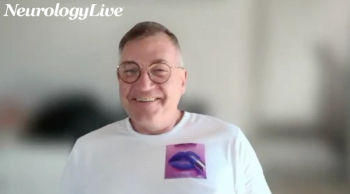
Outer Retinal Layer Thinning Non-Factor in Retinal Damage of AQP4-IgG NMOSD
Repeated analyses using both 3-mm and 1-mm diameter macular data—narrower volumes than standard—showed no relevant outer plexiform layer or outer nuclear layer thinning in those with seropositive AQP4-IgG.
Although patients with anti-aquaporin-4 antibody seropositive (AQP4-IgG+) neuromyelitis optica spectrum disorder (NMOSD) frequently suffer from optic neuritis (ON) leading to retinal neuroaxonal damage, new findings suggest that neither macular outer plexiform layer (OPL) nor outer nuclear layer (ONL) loss occurs in this patient population, regardless of ON phenotype.1
Senior author Frederike C. Oertel, MD, PhD, postdoctoral scholar, University of California, San Francisco, and colleagues evaluated outer retinal layer changes in 197 patients who were AQP4-IgG+ and 32 patients with myelin-oligodendrocyte-glycoprotein antibody seropositive (MOG-IgG+) along with 75 healthy controls. Patients underwent neurological examination as well as optical coherence tomography (OCT) to assess layer changes.
Using the 5-mm macular data, investigators found no evidence of significant thinning of OPL (25.02 µm [±2.03]) and ONL (61.63 µm [±7.04]) in patients who were AQP4-IgG seropositive compared with HC (OPL: 24.58 µm [±1.64]; ONL: 63.59 µm [±5.78]) or those who were MOG-IgG seropositive (OPL: 25.10 µm [±2.00]; ONL: 64.71 µm [±7.87]). They then repeated their analyses in both 3-mm and 1-mm diameter volumes around the fovea, but these narrower volumes again showed no relevant OPL or ONL thinning in the AQP4-IgG seropositive group as opposed to HCs or those who were MOG-IgG seropositive.
"Further studies will be necessary to clarify (1) if OPL and ONL are damaged in late disease stages due to retrograde trans-synaptic axonal degeneration across the damaged INL barrier and (2) if outer retinal dysfunction without a measurable structural correlate occurs," Oertel et al wrote. "Longitudinal studies could help quantify changes in the ORLs (outer retinal layer) alongside disease progression."
READ MORE:
Eyes of those who were AQP4-IgG seropositive with a history of ON did not display any thinning of ONL and OPL compared with patients without a history of ON or HC, despite severe neuroaxonal loss measured by peripapillary retinal nerve fiber layer (pRNFL) and ganglion cell and inner plexiform (GCIP) layer.
Neuroaxonal loss was not only comparable between the whole group of AQP4-IgG and MOG-IgG seropositive patients, but as well as in respect of ON and non-ON eyes. In comparison with HC, those with AQP4-IgG who had ON (B = –1.54 [standard error (SE), 0.69 µm]; P = .027) as well as those with MOG-IgG who had ON (B = –2.51 [SE, 0.87 µm]; P = .004) showed an OPL thinning in the fovea, but no difference was observed between the 2 non-HC groups (P = .100). Notably, no significant correlation was found between the impact of ethnicity and current therapies on outer retinal layer thickness.
The results of this study differed from those published by You et al in 2019 and Filippatou et al in 2020. In those studies, investigators described ORL thinning in the foveal and parafoveal area as a sign of AQP4-IgG-induced Müller cell damage.2,3
In You et al, b-wave amplitude, found to be significantly reduced in patients with AQP4-IgG+ NMOSD using scotopic electroretinography, was mainly caused by the reduction of the slow PII component, suggesting specific Müller cell dysfunction.2 Filippatou et al, who employed Cirrus-SD-OCT for the image acquisition, found total foveal thickness to not differ between AQP4-nonON and HC eyes. They also found lower ONL, inner photoreceptor segment thickness, and ONL photoreceptor segment thickness at the fovea and the surrounding macular, and lower RNFL and GCIP layer thickness.3
Both of these studies suggested the ORL changes to be caused by a primary retinal atrsocytopathy with AQP4-IgG associated glial dysfunction in Müller cells. “These pathological responses could account for the associated thinning observed in the ONL in these studies,” Oertel et al wrote. "However, other exogenous factors cannot be ruled out as contributory, such as cohort composition and study methodologies."1
REFERENCES
1. Lu A, Zimmermann HG, Specovius S, et al. Astrocytic outer retinal thinning is not a feature in AQP4-IgG seropositive neuromyelitis optica spectrum disorders. J Neurol Neurosurg Psychiatry. Published online October 28, 2021. doi:10.1136/jnnp-2021-327412
2. You Y, Zhu L, Zhang T, et al. Evidence of Müller glial dysfunction in patients with aquaporin-4 immunoglobulin G-positive neuromyelitis optica spectrum disorder. J Optha. 2019;126(6):801-810. doi:10.1016/j.ophtha.2019.01.016
3. Filippatou AG, Vasileiou E, He Y, et al. Evidence of subclinical quantitative retinal layer abnormalities in AQP4-IgG seropositive NMOSD. Mult Scler J. 2021;27(11):1738-1748. doi:10.1177/1352458520977771.
Newsletter
Keep your finger on the pulse of neurology—subscribe to NeurologyLive for expert interviews, new data, and breakthrough treatment updates.









































